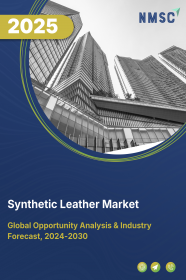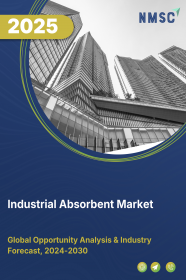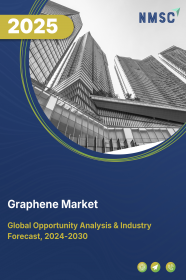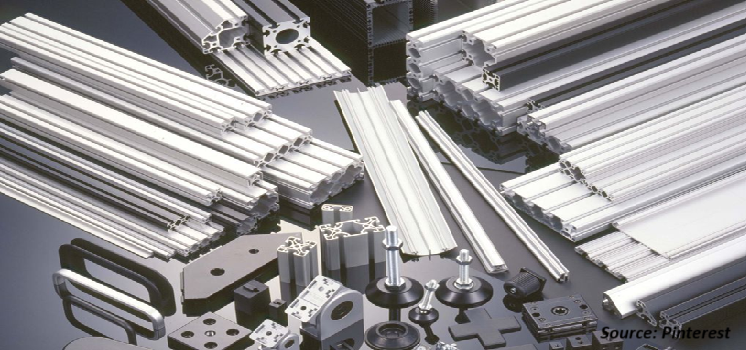
Synthetic Leather Market by Type (PU, PVC, and Biobased), by Application (Footwear, Headliners, Furnishing, Clothing, Bags & Accessories, and Others), and by End User (Fashion & Apparels, Automotive, Electronics, and Others) – Global Opportunity Analysis and Industry Forecast 2025-2030
US Tariff Impact on Synthetic Leather Market
Trump Tariffs Are Reshaping Global Business
Synthetic Leather Market Overview
The global Synthetic Leather Market size was valued at USD 49.56 billion in 2024 and is predicted to reach USD 71.14 billion by 2030 with a CAGR of 6.2% from 2025-2030.
The synthetic leather market, also known as or imitation leather or artificial leather refers to the global industry involved in the production and sale of leather materials made from plastics and other non-animal sources. This market encompasses various types of artificial leather, including polyurethane, and polyvinyl chloride that are used as alternatives to genuine leather in numerous applications.
Its ability to match the texture and appearance of real leather at a lower cost makes it an attractive option for consumers and businesses alike. Furthermore, its eco-friendly attributes, including reduced environmental impact and consideration for animal welfare, are in line with the growing sustainability trends observed in today's market.
Market Dynamics and Trends
The significant growth of automotive industry across the world attributes to the growth of imitation leather market as these leather offers a practical and affordable alternative to genuine leather, making it suitable for automotive interiors, while its alignment with environmental and ethical considerations meets the growing synthetic leather market demand for sustainable products. As per the Association of European Automobile Manufacturers, in 2022 the motor vehicle production across the globe reached 85.4 million units, indicating a 5.7% increase from 2021.
Such significant growth of the automotive industry worldwide not only drives the demand for artificial leather as a practical and sustainable alternative but also highlights its pivotal role in enhancing vehicle interiors with cost-effective solutions.
Moreover, stringent regulations worldwide aimed at protecting exotic animals are significantly boosting the synthetic leather industry, as the prohibition of animal-derived leather in various sectors drives the demand for artificial leather as a popular and effective alternative. For instance, the U.S. Congress passed a legislation on banning the import and sale of various animal skins, aiming to prevent major clothing and shoes brands from using animal leather in their products. Additionally, the European Union also passed a regulation on March 2022, on banning fur farming and the sale of farmed animal fur. As animal welfare initiatives continues to rise, the demand for artificial leathers continues to increase, boosting the market expansion.
Furthermore, the global expansion of the furnishing industry is accelerating the growth of the market, as increased furniture production drives demand for affordable and durable materials such as artificial leather to enhance design versatility and product longevity. According to Business and Institutional Furniture Manufacturer's Association, office and institutional furniture market size of U.S. rated 16.429 billion in 2022. Similarly, in UK the furniture manufacturing totalled USD 12.11 billion in 2022. Such expansion of the furnishing industry, driven by increased furniture production, is a significant factor accelerating of the artificial synthetic leather market growth.
However, the harmful effects of PU and PVC based synthetic leather such as environmental pollution, health risks, and non-renewable sourcing, restrain the growth of the artificial leather sector.
On the contrary, the emergence of bio-based faux leather is anticipated to create ample growth opportunity in the forthcoming years. These renewable sources present a compelling alternative to traditional synthetic leather made from petrochemicals by addressing consumer demand for eco-friendly products while meeting stringent regulatory sustainability standards, thereby reducing environmental impact across various industries.
Market Segmentations and Scope of the Study
The synthetic leather market report is segmented on the basis of type, application, and end-user. On the basis of type, the market is divided into PU, PVC, and biobased. Based on application, the market is categorised into footwear, headliners, furnishing, clothing, bags & accessories, and others. Based on end-user, the market is segmented into fashion & apparels, automotive, electronics, and others. Regional breakdown and analysis of each of the aforesaid segments includes regions comprising of North America, Europe, Asia-Pacific, and Rest of The World (Row).
Geographical Analysis
Asia-Pacific region holds the dominant in synthetic leather market share during the forecast period. The rapid expansion of the automotive sector in this region particularly in countries such as China and India drive growth in adoption of artificial leather an effective alternative to genuine leather for vehicle interiors. According to International Trade Administration report of 2023, China is the world’s largest automotive market, with domestic production expected to reach 35 million units by 2025. Such expanding automotive sector accelerates the demand for imitation leather for maintaining versatility in vehicle interiors.
Moreover, the presence of major key players in the region such as Daikin Industries, Ltd., Toray Industries, Inc., Indofil Industries Limited, Filwel Co. Ltd., and R. Polycoats Pvt. Ltd. drive market growth through continuous innovation, launching new products to meet evolving consumer demands. For instance, in October 2022, Toray Industries Inc. launched Ultrasuede a 100% plant-based polyester for ANA Green Jet headrest covers. The product features eco-friendly materials with around 30% plant-based polyurethane incorporated into the non-woven structure and an additional 30% plant-based polyester in the reinforcement fabric.
On the other hand, North America is expected to show a steady rise in the synthetic leather market during the forecast period due to rise in demand of footwear in the region. Imitation leather emerged as a favoured choice for footwear manufacturers in the U.S., offering an economical and adaptable substitute to genuine leather. As per Footwear Distributors and Retailers of America, Americans spent USD 112.7 billion on shoes in 2023. Based on such significant demand and the expanding footwear industry in region, the imitation leather industry is poised for further acceleration.
Moreover, the expansion of the fashion industry in the region is driving the growth of the synthetic leather market, as these materials provide designers and consumers with a versatile, cost-effective, and sustainable alternative to genuine animal-based leather. According to Global Council for Promotion of International Trade, the U.S. fashion industry is one of the largest industries in this region, with the industry valued at over USD 400 billion in 2023. Such expansion in the sector signifies the growth of fashion industry, thereby surging the growth of the imitation leather market.
Competitive Landscape
Various key players operating in the synthetic leather industry includes Kuraray Co. Ltd., H.R. Polycoats Pvt. Ltd., Alfatex Italia SRL, Filwel Co. Ltd., Yantai Wanhua Synthetic Leather Group Co. Ltd., San Fang Chemical Industry, General Silicones (GS), Nan Ya Plastics Corporation, Asahi Kasei, Teijin Cordley Limited and others. These companiesare adopting various strategies such as partnership and product launches to remain dominant in the market.
For instance, in October 2023, Asahi Kasei partnered with U.S.-based startup NFW. The partnership aims Sage to help car makers worldwide cut their environmental footprint by creating a non-petroleum-based, fully circular leather alternative.
Moreover, in August 2023, Teijin Cordley Limited collaborated with WR Supply to use advanced technology to convert 100% recycled paper into base paper for artificial leather release paper. The resin coating used in the product acts as a transfer mold, creating intricate patterns and textures on the synthetic leather surface, mimicking the look of natural leather.
Furthermore, in June 2022, Kuraray Co., Ltd. launched man-made leather, CLARINO. The product is featured on Lenovo Japan’s ThinkPad Z13 laptop series and it meets the high standards required for the ThinkPad's top panel, offering scratch resistance, abrasion resistance, chemical resistance, and excellent stamping workability.
Key Benefits
-
The report provides quantitative analysis and estimations of the synthetic leather market from 2024 to 2030, which assists in identifying the prevailing market opportunities.
-
The study comprises a deep-dive analysis of the current and future synthetic leather market trends to depict prevalent investment pockets in the industry.
-
Information related to key drivers, restraints, and opportunities and their impact on the synthetic leather market is provided in the report.
-
Competitive analysis of the players, along with their market share is provided in the report.
-
SWOT analysis and Porters Five Forces model is elaborated in the study.
-
Value chain analysis in the market study provides a clear picture of roles of stakeholders.
Synthetic Leather Market Key Segments
By Type
-
PU
-
PVC
-
Biobased
By application
-
Footwear
-
Headliners
-
Furnishing
-
Clothing
-
Bags & Accessories
-
Others
By End Use
-
Fashion & Apparels
-
Automotive
-
Electronics
-
Others
By Region
-
North America
-
The U.S.
-
Canada
-
Mexico
-
-
Europe
-
The U.K.
-
Germany
-
France
-
Italy
-
Spain
-
Denmark
-
Netherlands
-
Finland
-
Sweden
-
Norway
-
Russia
-
Rest of Europe
-
-
Asia-Pacific
-
China
-
Japan
-
India
-
South Korea
-
Australia
-
Indonesia
-
Singapore
-
Taiwan
-
Thailand
-
Rest of Asia-Pacific
-
-
Rest of the World (RoW)
-
Latin America
-
Middle East
-
Africa
-
Key Players
-
Kuraray Co. Ltd.
-
H.R. Polycoats Pvt. Ltd.
-
Alfatex Italia SRL
-
Filwel Co. Ltd.
-
Yantai Wanhua Synthetic Leather Group Co. Ltd.
-
San Fang Chemical Industry
-
Mayur Uniquoters Limited
-
Nan Ya Plastics Corporation
-
Zhejiang Hexin Industry Group Co. Ltd.
-
Teijin Limited
REPORT SCOPE AND SEGMENTATION:
|
Parameters |
Details |
|
Market Size in 2023 |
USD 49.56 Billion |
|
Revenue Forecast in 2030 |
USD 71.14 Billion |
|
Growth Rate |
CAGR of 6.2% 2025 to 2030 |
|
Analysis Period |
2024–2030 |
|
Base Year Considered |
2024 |
|
Forecast Period |
2025–2030 |
|
Market Size Estimation |
Billion (USD) |
|
Growth Factors |
|
|
Countries Covered |
28 |
|
Companies Profiled |
10 |
|
Market Share |
Available for 10 companies |
|
Customization Scope |
Free customization (equivalent to up to 80 working hours of analysts) after purchase. Addition or alteration to country, regional, and segment scope. |
|
Pricing and Purchase Options |
Avail customized purchase options to meet your exact research needs. |







 Speak to Our Analyst
Speak to Our Analyst





















